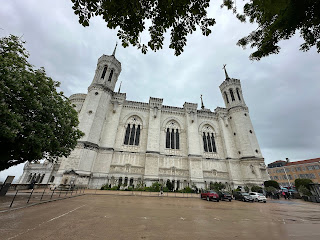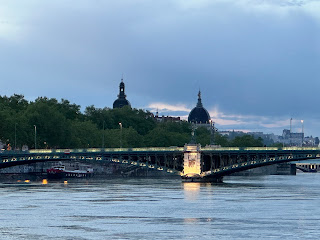For our final day on the river cruise, we finally toured the city of Lyon. We were supposed to arrive on Sunday afternoon and have Monday for touring before leaving the ship for Geneva. Of course, we ended up arriving on Friday instead. Here are a few photos of the evening lights at our sail in:
The photos above were actually taken on the Saone River, not the Rhone. If you look at a map of Lyon, the city sits at the confluence of the two rivers, but it is the Rhone that seems to flow into the Saone from the east. In fact it is the smaller Saone that flows in from the north. The Rhone has its source in the Swiss Alps - and coincidentally, we have seen it. In 1992 we did a driving trip with my parents through Germany and Switzerland, and while we were driving across the Furka Pass, we had an opportunity to check out the Rhone Glacier.
Over the course of the weekend we did have a couple of short cruising opportunities. As quite a few river boats were in Lyon, either because of the inaccessibility of the Saone or because they were supposed to be there, the boats moved positions as needed to accommodate passenger turn arounds or supplies loading as it was much easier to do if that boat was up against the shore, not rafted on to another vessel. So we had a couple of different berth positions, including one that put us on the Rhone River side of the confluence for one night.
At any rate, Monday dawned pretty much as usual - cloudy and at the very least threatening rain. That didn't start until we were on the buses for our morning city tour. By this time we were all getting pretty tired of the rain, and were hoping it would stop by the time we started the old city walking part of the tour.
Our first stop was up on one of the hills of Lyon, at the Basilica of Notre-Dame de Fourviere. This basilica is dedicated to The Virgin Mary and the church on the hill has a history dating back to 1168, when a chapel was erected on the site. The chapel was destroyed in 1562 when the Protestants captured the city. It was reconstructed at the end of the 16th Century.
The church was elevated to basilica because of 3 events - maybe they should rightly be called miracles:
1638 - a serious scurvy epidemic hit the children of the city, and they could do nothing to stop it. The hospital administrators walked in a procession to Fourviere, and after that, the scurvy disappeared and never returned;
1643 - the Black Death was threatening Lyon as it was all of Europe. On Sept 8, the day before the Nativity of the Virgin Mary, the mayor and his aldermen decided to put the city under the protection of Mary, and walked to Fourviere in a procession. In the Chapel of the Virgin, they vowed to every year go to the Chapel and listen to mass on that day, and offer the Archbishop wax, candles and a gold crown (currency) if their wishes were fulfilled. The Plague did not affect the city, and the people of Lyon still carry on this tradition today.
1832 - the cholera epidemic threatened the city, and the Archbishop recommended public prayers. Lyon was spared from the disease and in gratitude the people of Lyon had local artist Victor Orsel paint a huge painting. It is 6.75 metres high x 5 metres wide, and it an allegory of the defeat of the epidemic.
 |
| There are Roman era archaeological sites from when the city was known as Lugdunum on Fourviere not far from the basilica |
 |
| A side view of the basilica, taken where I could stay out of the rain |
 |
 |
| There are 6 beautiful huge tile mosaic murals in the church that must have taken years to complete |
 |
| The view over Lyon from the basilica |
After our visit to Fourviere, our buses took us back down into the city. On the way, we had a view of Fourviere with the Basilica and the 'metallic tower'. Yes, it does look like the Eiffel Tower, but it is a telecommunications tower. It was erected in the 1890s and during the Exposition Universelle in 1914 it had a restaurant and an elevator, so it really was a mini-Eiffel Tower. Note the raindrops on my bus window...
 |
Just in time for even more rain, we began our walking tour. It absolutely poured rain for most of our visit, and we were far from the only groups walking around in the old city. The locals all had enough sense to stay home!
 |
| We passed a fountain not long before leaving the bus. Even then the rain was streaming down the windows. |
One of the interesting design aspects of old Lyon is the series of hidden passageways between streets, called 'traboules'. They were apparently initially used by the merchants and silk weavers of Lyon to transport their goods more easily around the city, and also allowed people easier access to the Saone River. Access to the apartments is via staircases in courtyards or common areas in between the two streets.
 |
| One of the passageways |
 |
| which led to a small open area with staircases to the upper levels and a tower. Towers were apparently a staple of the courtyards |
 |
| One of the old streets. The doors to the traboules look very similar to any other along the road, but are marked with a medallion to identify them. |
 |
| One of the courtyards |
 |
| All of the old 'residences' are now apartments |
After our uncomfortably wet walking tour we reboarded our coaches and drove the 20 minutes to our special lunch destination, the famous Paul Bocuse restaurant - or the Abbaye de Collonges 'event centre'. There were over 80 of us including the tour directors, and the actual restaurant isn't that big - never mind that it was probably booked out for lunch anyway, as this event was put together by Tauck's head office less than a week earlier.
 |
| L'Abbaye as we walked up from the coaches |
 |
| There's a Circus theme to everything around here, and we wondered why |
 |
| Love the door handles! |
Apparently the Abbaye was also used as a restaurant. According to our local guide, this area with the large fireplace was originally where guests were served their meals.
We were then ushered into the reception room where we were served with Kirs (white wine and cassis liqueur) and small appetizers. Still more circus theme in the decor.....
All we could say was 'Wow!!!' as this huge pipe organ started playing! Here's a little 'mix' of the music it played for us:
Now we know why there's a circus theme! According to the little story of the Pipe Organ that came with our menus, written by Bocuse himself, a local merchant family had commissioned the mechanical organ for this room at the Abbaye so the village would have music and dancing on Saturday nights. This worked well until World War I, when the whole Abbaye was used as a field hospital of sorts. The organ was walled up to hide it from possible German invasion and destruction, and it was forgotten there for many years. In 1966, Paul learned of the organ and had the wall taken down. It took 4 years to restore it to working order, and in 1970 it performed for the first time in more than 50 years.
Now that you've seen the menu, here are the photos of lunch:
 |
| Cassolette of Lobster, a sort of Lobster Bisque |
 |
| Love the etched wine glasses |
 |
| Medallion of Veal with Smitane Sauce |
 |
| The cheese course - Goat Cheese and Saint Marcellin |
 |
| and Dessert, a cheesecake with raspberry sauce |
What an amazing afternoon that was after a depressing wet morning! Did you notice that the rain had stopped by the time we reached the restaurant??
 |
| Marble cheesecake with a lavender macaron, ice cream and purple 'white' chocolate. |
We had to be fairly early again, but at least we kept our suitcases with us overnight. They would be picked up from our staterooms after we left on the coaches and transported to the hotel in Geneva for us. Yet again, we went to bed with our fingers crossed that the morning would be sunny and warm......






















No comments:
Post a Comment